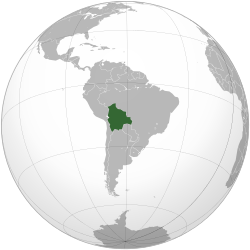1980 Bolivian coup d'état
| Republic of Bolivia | ||||||||||
| República de Bolivia | ||||||||||
|
||||||||||
|
||||||||||
|
Motto "¡La unión es la fuerza!" (Spanish) "Unity is Strength!" |
||||||||||
|
Anthem Himno Nacional de Bolivia (Spanish) |
||||||||||
| Capital | Sucre, La Paz | |||||||||
| Languages | Spanish, Quechua, Aymara, Guaraní, others | |||||||||
| Religion | Roman Catholicism (official) | |||||||||
| Government | Republic under military dictatorship | |||||||||
| President | ||||||||||
| • | 1964-1969 | René Barrientos (first) | ||||||||
| • | 1982-1982 | Celso Torrelio (last) | ||||||||
| Legislature | Junta of Commanders of the Armed Forces | |||||||||
| Historical era | Cold War | |||||||||
| • | Coup d'état | November 4, 1964 | ||||||||
| • | Disestablished | October 10, 1982 | ||||||||
| Currency | Bolivian peso | |||||||||
|
||||||||||
| Warning: Value specified for "" | ||||||||||
The history of Bolivia from 1964 to 1982 is a time of periodic instability under various military dictators. On November 4, 1964 power passed from the elected leader of the Bolivian National Revolution, Víctor Paz Estenssoro to a military junta under vice-president General René Barrientos. Barrientos was elected president in 1966, but died accidentally in 1969, leading to a coup in September 1969 by General Ovando, who was owerthrown in October 1970 by General Rogelio Miranda who was overthrown a couple of days later by General J.J.Torres, who in turn was owerthrown on August 1971 by Hugo Banzer Suárez. Banzer ruled for seven years, initially from 1971 to 1974 with the support of Estenssoro's Nationalist Revolutionary Movement. In 1974, impatient with schisms in the party, he replaced civilians with members of the armed forces and suspended political activities. The economy grew impressively during Banzer's presidency, but demands for greater political freedom undercut his support. He called elections in 1978 and Bolivia once again plunged into turmoil. Juan Pereda ruled for only four months in 1978, but his ascent to the presidency marked the beginning of an even more unstable period in Bolivian history, with nine civilian and military presidents in little over four years (1978–1982). 1982 marked the return to a democratically elected government, with Guido Vildoso as president.
On November 4, 1964 René Barrientos Ortuño (president, 1964–65; co-president, May 1965 – January 1966; and president, 1966–69) and General Alfredo Ovando Candia occupied the presidential palace and declared themselves co-presidents. But as the crowd, which had gathered outside the palace, persisted in shouting its preference for the more charismatic Barrientos, Ovando allowed Barrientos to assume the formal title alone, while he occupied the post of commander in chief of the armed forces.
...
Wikipedia



